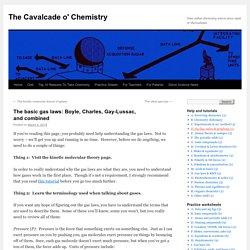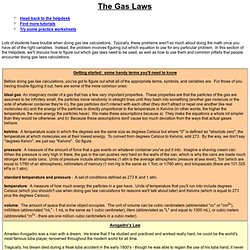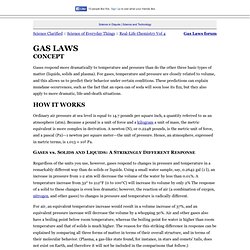

Gas Laws. Gas Laws - Problems. The basic gas laws: Boyle, Charles, Gay-Lussac, and combined. If you’re reading this page, you probably need help understanding the gas laws.

Not to worry – we’ll get you up and running in no time. However, before we do anything, we need to do a couple of things: Thing 1: Visit the kinetic molecular theory page. In order to really understand why the gas laws are what they are, you need to understand how gases work in the first place. Though it’s not a requirement, I strongly recommend that you read this tutorial before you go too much further. Thing 2: Learn the terminology used when talking about gases. If you want any hope of figuring out the gas laws, you have to understand the terms that are used to describe them. Pressure (P): Pressure is the force that something exerts on something else. Gas Laws. Gas Laws. Animated Gas Lab. Gas Labs Mark II. Molecular Model for an Ideal Gas.
Practice Chemistry Worksheets! All about the gas laws. The Ideal Gas Law What happens if you don't change the conditions of a gas, but just want to find out what a gas is like when it's sitting in a container, not doing much?

Well, the equations above won't help you much, because they're equations which depend on making a change and comparing the conditions before the change and after the change to make determinations about what the gas is like. The ideal gas law is an equation of state, which means that you can use the basic properties of the gas to find out more about it without having to change it in any way. Because it's an equation of state, it allows us to not only find out what the pressure, volume, and temperature are, but also to find out how much gas is present in the first place. Here it is: PV = nRT Where P is the pressure of the gas (either in atmospheres or kilopascals), V is the volume (in liters), n is the number of moles, R is the ideal gas constant, and T is the temperature (in Kelvins). Let's see an example:
Gas Laws. Gases respond more dramatically to temperature and pressure than do the other three basic types of matter (liquids, solids and plasma).

For gases, temperature and pressure are closely related to volume, and this allows us to predict their behavior under certain conditions. These predictions can explain mundane occurrences, such as the fact that an open can of soda will soon lose its fizz, but they also apply to more dramatic, life-and-death situations. Ordinary air pressure at sea level is equal to 14.7 pounds per square inch, a quantity referred to as an atmosphere (atm). Because a pound is a unit of force and a kilogram a unit of mass, the metric equivalent is more complex in derivation. A newton (N), or 0.2248 pounds, is the metric unit of force, and a pascal (Pa)—1 newton per square meter—the unit of pressure.
GASES vs. Regardless of the units you use, however, gases respond to changes in pressure and temperature in a remarkably different way than do solids or liquids. . Charles Law Interactive experiment.